Seeing Things: March 2010 Archives
Come Fly Away / Marquis Theatre, NYC / New York premiere March 25, 2010
Given Twyla Tharp's incisive intelligence and no-holds-barred manner, you'd never expect her to fall for the sentimental, beguiling songs of Frank Sinatra, but she has, over and over again. Come Fly Away, which opened at the Marquis Theatre March 25 after three weeks of previews, is the latest result. Considering Tharp's investment in the show--the talent, the time, the cultivation of backers (the cost of such entertainments is astronomical), the grueling effort to get it to Broadway--I wanted it to be wonderful. It isn't.
For one thing, it's hard to know what the show's "about." Its website, which seems to be pitching the production as a kind of Valentine's Day stimulus, reveals only that "Fifteen of the world's best dancers tell the story of four couples falling in and out of love at a swinging nightclub on a star-lit evening." Journalists covering the musical's premiere in Atlanta last fall (when it was called Come Fly With Me) or writing previews for its New York opening did a lot of explaining about each figure in the eightsome and the vagaries of their love lives as Tharp describes these things in interviews. From this evidence, you'd assume the show has solid characters and a clear plot. But if you just walk into the Marquis and simply watch what's going on onstage, you'll be hard put to figure out what's going on narrative-wise, let alone who's who.
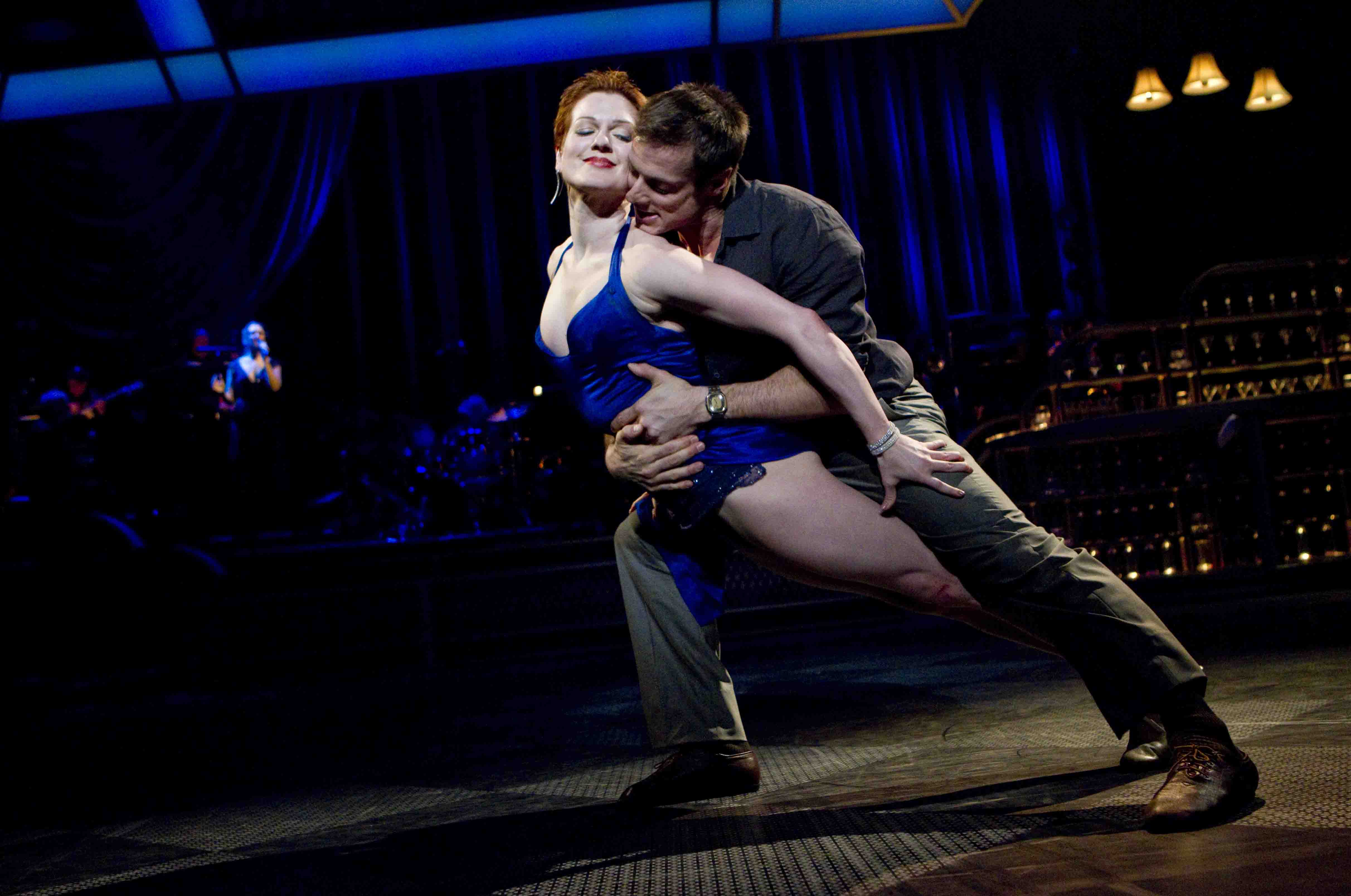
Holley Farmer and John Selya in Twyla Tharp's Come Fly Away
Photo: Joan Marcus
Of course, you know where you are, from James Youmans's gaudy set, which suggests an Art Deco drinks-and-dancing nightspot--on steroids. Spacious enough for dancing on an intimate scale, it also provides an upstage platform for a 19-piece band (conducted by Russ Kassoff), a well-stocked bar to the right, a sprinkling of small tables and chairs, and a backdrop that assures us the night is full of stars. Katherine Roth's costumes are simple and timeless, all swirl and sheen. This elegance is punctuated, when the going gets hot, with vulgarity that is, alas, overdone and, worse still, unimaginative.
About that band: While it's live, it accompanies the actual Sinatra's caressing voice, scooped out of the crooner's recordings. (The digitized Sinatra is relieved from time to time by the live and lovely vocalist Hilary Gardner.) But maybe we shouldn't be so picky concerning this curious arrangement. After all, Sinatra's family and estate have given their blessing to the entire project.
The oddity of Come Fly's means of capturing Sinatra turns out to be the least of the show's difficulties. The brazen gaudiness of the whole affair is another, but that's show biz. The central flaw is that the audience is left to intuit a story or stories from hints in a continuum of some of the busiest dancing it has ever seen. If the show does have a plot (or even a point beyond the observation that love's tough), it's not all that clear.
We meet each of the four main couples in their relationships of the moment, but they soon split--through temperamental differences, quarrels, misunderstandings, or the cruel desire to try out an alternative lover. As if someone had yelled, "Change partners and dance!" the eight "characters," most of whom are given no more depth than paper dolls, are shuffled like a deck of cards. About half of them seem to get together again as the show moves toward its finale, but by that time--exhausted by the volatile coupling, the incursions of a feisty ensemble, and the merciless visual cacophony--I, for one, had lost track.
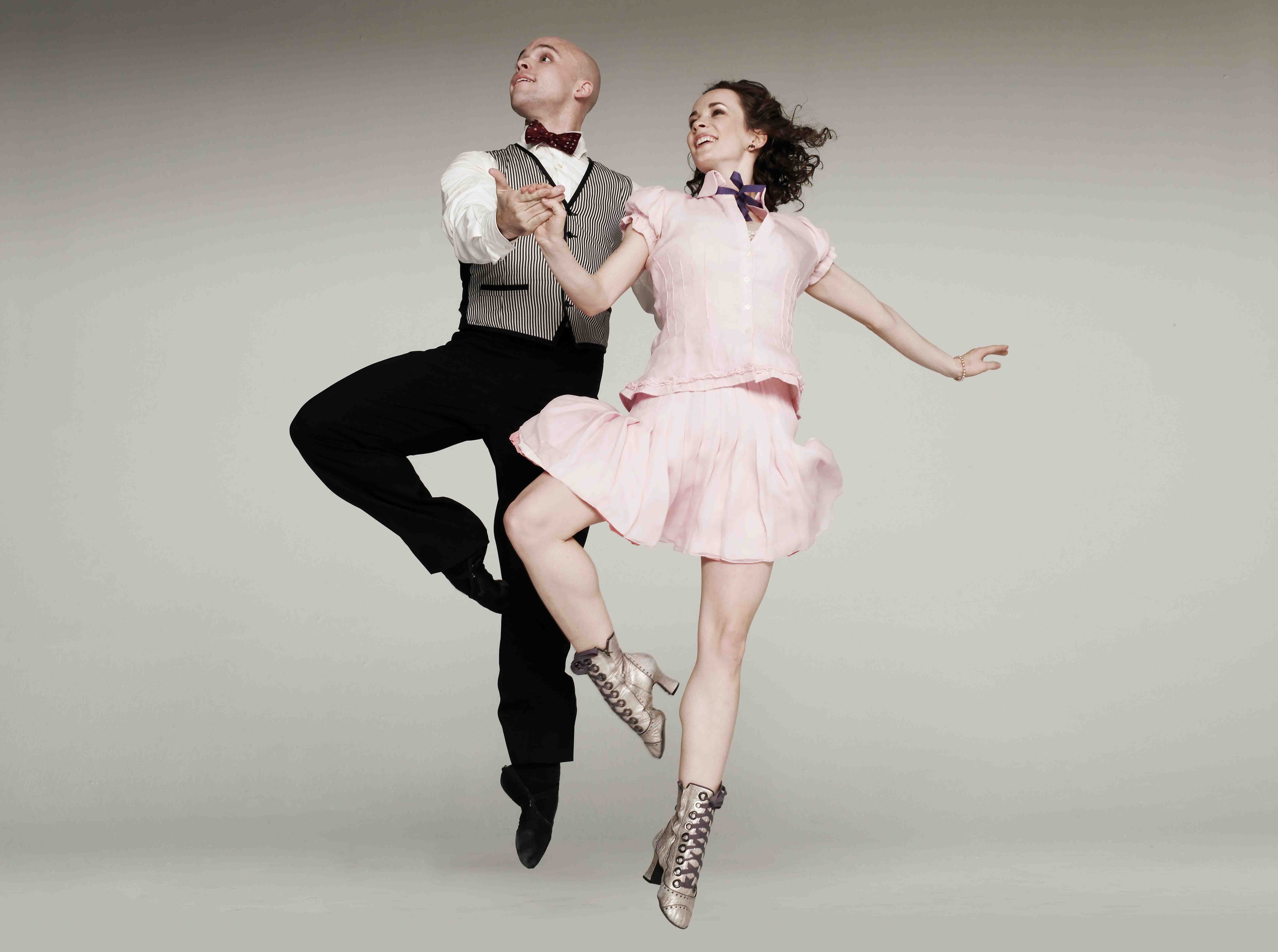
Charlie Neshyba-Hodges and Laura Mead
Photo: Ruven Afanador
Back in the Sixties, when Tharp began choreographing, she worked in the world of concert dance--eschewing even theaters at the start; one terrific piece was performed in Central Park, in a field of grass. Abstract or semi-abstract choreography were the prevailing modes. Tharp didn't need to worry about narrative chops. And hers have since proved to be conspicuously weaker than her dazzling invention in the realm of movement.
Tharp being Tharp, though, once she fixed on the Great White Way as her goal, was bent on effecting radical changes in the Broadway musical's conventions, dispensing with spoken narrative and allowing dance and song to be the sole conveyors of events and emotions. Her 2002 Movin' Out, set to Billy Joel's music--a tremendous hit, running for three years and garnering a Tony award--was created along these lines. Next up, in 2006, was The Times They Are A-Changin', to Bob Dylan songs. It was a colossal flop.
Now we have Come Fly Away, the fourth of Tharp's rendezvous with Sinatra. Its predecessors?
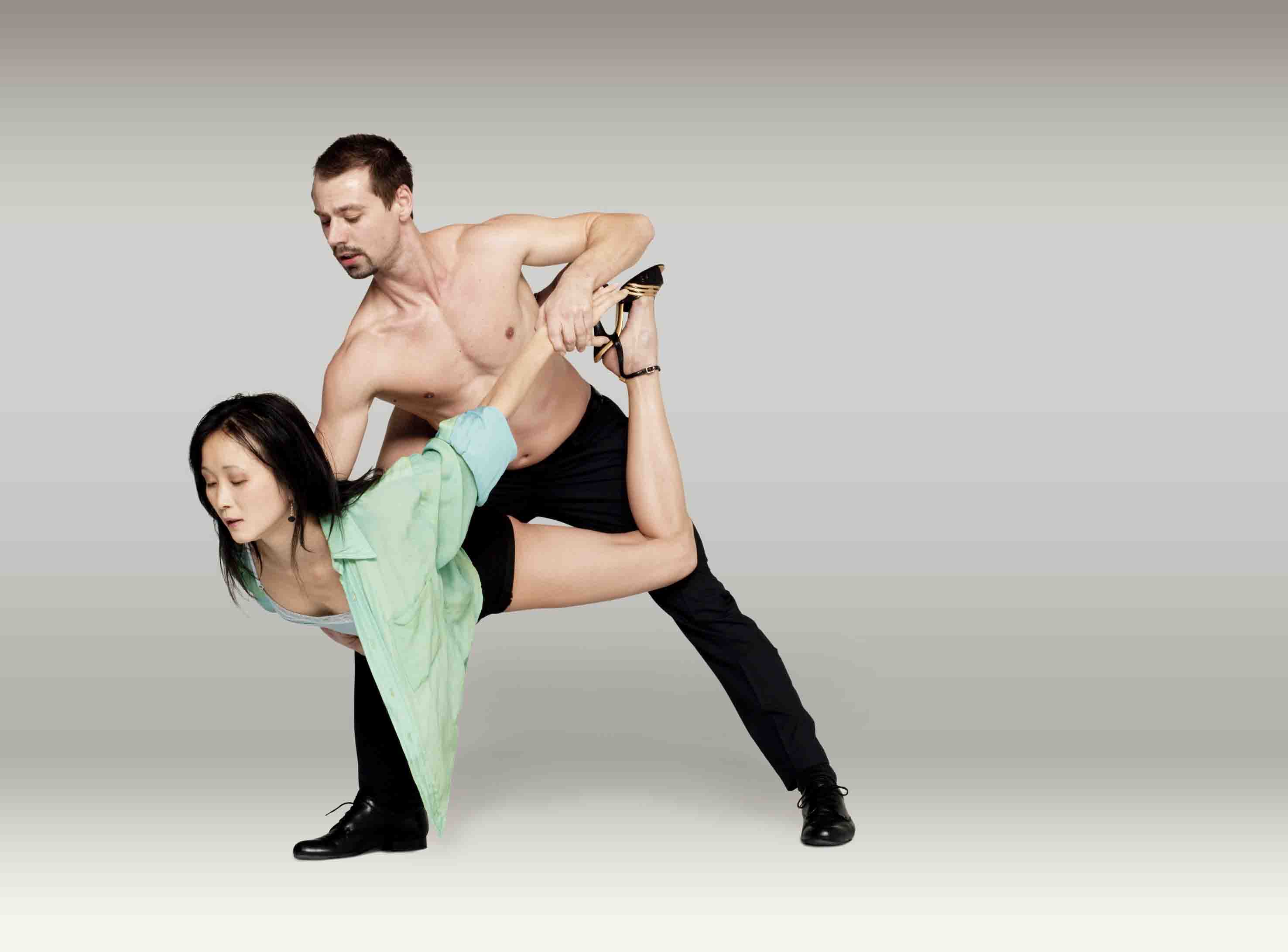
Rika Okamoto and Matthew Stockwell Dibble
Photo: Ruven Afanador
Once More Frank (1976), a duet created for an American Ballet Theatre gala, in which Tharp juxtaposed her own maverick style--a delicious mix of ballet, jazz, modern, boxing, pedestrian moves, et al.--with Mikhail Baryshnikov's pure classicism.
Nine Sinatra Songs (1982), created for the company Tharp maintained at the time, remains her best effort in tandem with Ol' Blue Eyes. It's simply a string of duets for different pairs rendered in suite form. The nature of each of the relationships portrayed--sublime, troubled, violent, romantic, ebullient, sweetly bumbling--is crystal clear and entirely satisfying, not least because it leaves the impression of real people, real situations, and real feelings. Generalized and idealized as it is, the viewer comes away from it thinking, Yes, that's what love is like.
Some of the material in this piece resurfaces in Come Fly Away, rethought and reworked. True, it fits our era that the apache dance, which originally (and traditionally) gave us woman-as-victim, now shows us a woman who gives as good as she gets. Overall though, the older versions, more modestly presented, were quite possibly perfect.
Sinatra Suite (1984), made for ABT, is a condensed and modified spin-off of Nine Sinatra Songs, now showing a single couple in various phases of a romantic relationship. Although it's an attractive (and easily portable) piece, in the end less is less.
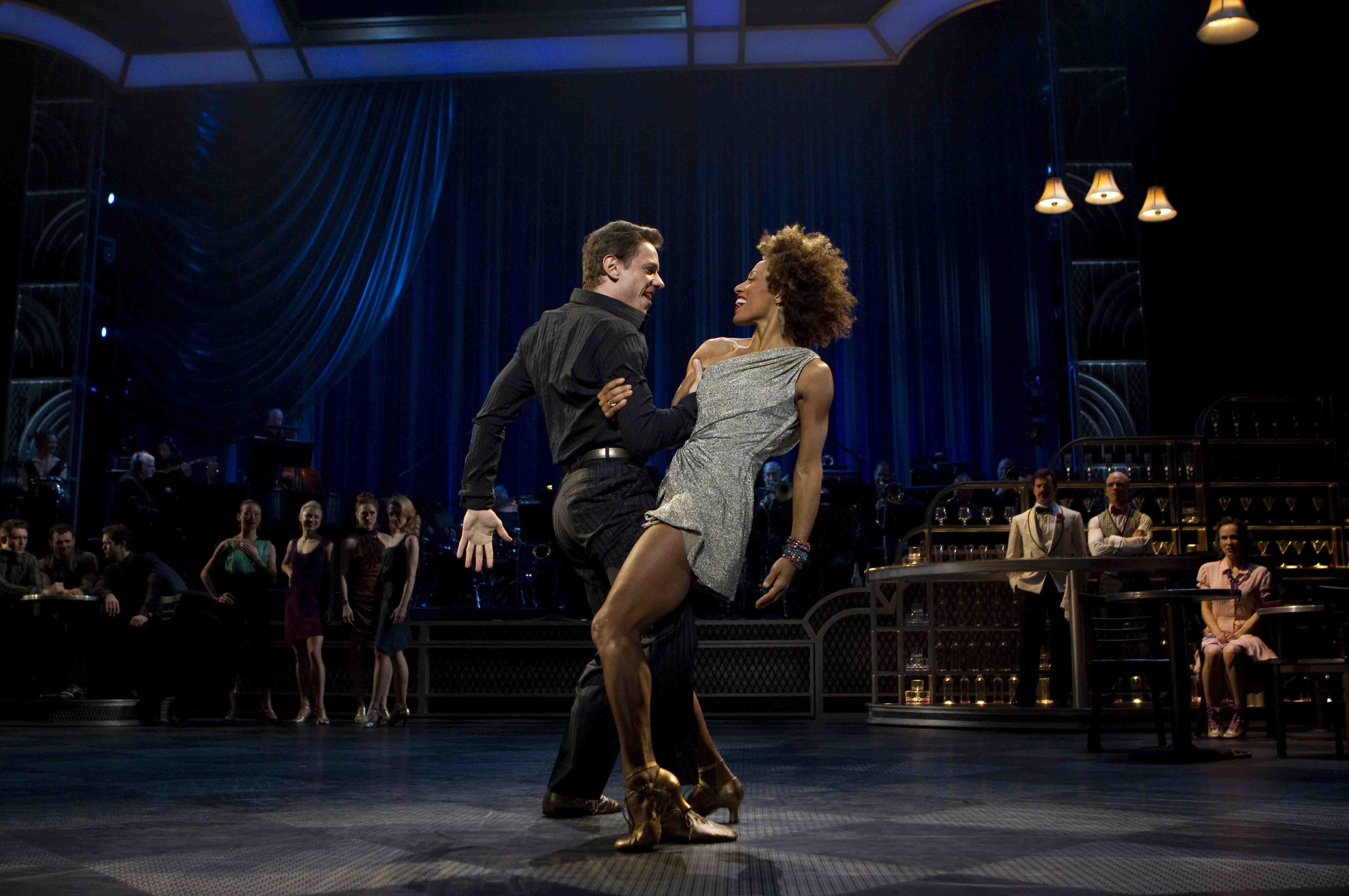
Keith Roberts and Karine Plantadit
Photo: Joan Marcus
The element of Come Fly Away that can hardly fail to delight most spectators is its superb dancing. John Selya, a Tharp veteran (as are several in the cast), lends the show a texture it otherwise lacks in a ruminative solo set to "The September of My Years." Other standouts are the sensuous Holley Farmer, on the rebound from the Merce Cunningham Dance Company; Matthew Stockwell Dibble, the personification of classical ballet's sublime harmony, who is also eloquent (and funny!) as a guy who's totally stoned; and Karine Plantadit, from Ailey and The Lion King, who seizes the stage by overdoing everything a lascivious tigress is meant to do.
Just about every dancer in this show--ensemble members as well as featured players--is a marvel of technical brilliance, charged energy, charismatic projection, and wildcat daring. After a while, you wish they'd tone it down a bit. More and more, as her career progresses, Tharp tends to favor an unremitting pull-out-all-stops mode. Granted, she works wonders with it but, operating in this way, she neglects the very element that make tempestuous passages effective: movement that's calm, quiet, contemplative. Call it adagio--allegro's best friend.
© 2010 Tobi Tobias
Limón Dance Company / Baryshnikov Arts Center, NYC / February 9 -10, 2010
Sokolow Theatre/Dance Ensemble: Anna Sokolow Birthday Tribute / 92nd Street Y, NYC / February 14, 2010
Limón Dance Company / 92nd Street Y, NYC / March 5-7, 2010
Can dance history exist without dancing? How can we make the choreography we treasure survive? Much of the history of the art exists in words written about dancing. Even at its most evocative or detailed, such evidence preserves dance at several removes. With passing time, the ways of recollecting what is, ironically, the wordless art, expanded beyond text, drawings, and notation to still photography, and then to recorded motion via film and video. Yet none of these methods, invaluable though they are, comes anywhere close to recreating live performance, with its visceral thrill.
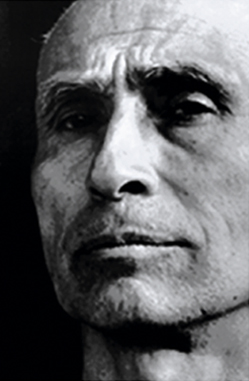
Recently, showings by the Limón Dance Company and the Sokolow Theatre/Dance Ensemble demonstrated the efforts being made to keep dances by José Limón and Anna Sokolow in the working repertory, although seven decades have passed since the earliest of these pieces was created. The job would be uphill work at any time, because the ticket-buying public has the final word about which dances live or die and the general viewer has scant interest in past glories. Just now the task is even tougher, today's dismal economy being ruthlessly unkind to the arts.
Limón and Sokolow had much in common. Close in age, both were prominent in the generation of choreographers that followed the era of the radical innovators--Martha Graham and Doris Humphrey at their fore--who essentially defined American modern dance as a distinct, dynamic genre. Sokolow was a member of Graham's early company; Limón was Humphrey's protégé. Limón was Mexican-born, and the vivid culture of his birthplace infiltrates many of his works as a melodramatic, even surrealistic element; Sokolow was fascinated by Mexico and spent a significant amount of time there, touring and teaching. Both were dead serious and both explored the human psyche, often its dark side. (I've been told that Sokolow's preoccupation with gloom earned her the sardonic nickname of "Little Mary Sunshine.") Both choreographers were very much of their time; the work of both, I believe, deserves a life beyond it.
The Limón company, led by Carla Maxwell, a former star dancer with the group, is in the stronger position by far, boasting an unbroken existence since Limón's death. With the choreographer's works augmented by others carefully chosen or commissioned to be compatible with Limón's humanistic values, it can still present itself as an established group offering pleasure and food for thought to the general public. Still, it has gone through precarious periods, and may indeed be in one now, with only short, intermittent engagements in New York.
Appearing at the Baryshnikov Arts Center (BAC) February 9 and 10, the Limón troupe offered two dances that have long been considered masterpieces. Limón's 1956 There Is a Time, is set to Norman Dello Joio's Meditations on Ecclesiastes, commissioned for the dance and winner of a Pulitzer Prize. The full cast represents a community that, hands linked, keeps re-forming in a moving circle, a thematic statement that frames and formalizes solos, duets, and small groups. These vignettes illustrate the consoling Biblical passage that acknowledges the vastness of human experience (birth and death; planting and harvesting; love and war) and counsels "To every thing there is a season, and a time to every purpose under heaven."
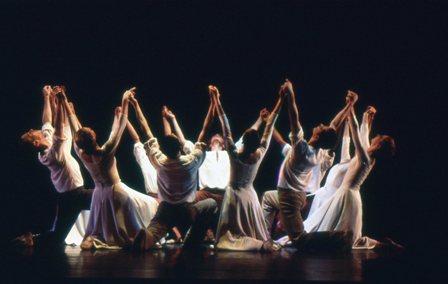
The Limón Dance Company in Limón's There Is a Time
Superbly danced--as it was only sporadically here--it's a lovely piece, if just a season or two too long, as are many of Limón's efforts. "Cut it in half and fix the rest," Humphrey often told emerging choreographers, but Limón chronically failed to follow this sound, if severe, advice.
At this showing, I particularly liked Logan Kruger's appearances as a woman who is comfort itself and Kathryn Alter in the dark roles. The male soloists were fully adequate to their assignments but none of them made me feel I'd remember them forever--as I do Nina Watt in "A time to laugh . . . a time to dance." Watt was so utterly the image of a wildly giggling child, the epitome of buoyant, irrepressible delight, that the role might as well have been retired when she retired. Overall, the current Limón dancers are undeniably experts in softness, sensitivity, fluency, and accuracy of detail. What they need most just now is a walloping dose of impetuousness; they are too pleasant and too neat.
The other item on the BAC program was Anna Sokolow's Rooms, generally considered her masterpiece (to the neglect, perhaps, of the rest of her repertoire). Rooms is a superb work, as pertinent on the subject of urban loneliness and isolation as it was at its making in 1955. Simply by assigning each dancer a stark wooden chair as his or her home base, the choreographer leads us to imagine a low-end rooming house in which individuals with drastically limited human intercourse drown in their despair or dream heart-breakingly impossible dreams.
All the segments of the piece were thoughtfully danced, but Kristen Foote and Daniel Fetecua Soto emerged as its stars. "Escape" gave us Foote, soft, powerful, and sexy as hell in an orangey-pink dress, revving up for a romantic encounter. After a mimed toilette in which she luxuriated in her own beauty, she leaned from her chair to caress an invisible beau in an empty chair she'd placed opposite hers. As convincing as her anticipation of sensual pleasure--and, simply, connection--were the moments when her confidence evaporated, perhaps as she remembered bitter, even humiliating, past experiences. Then grief broke through--until she forced herself, once again, to imagine that this time . . .
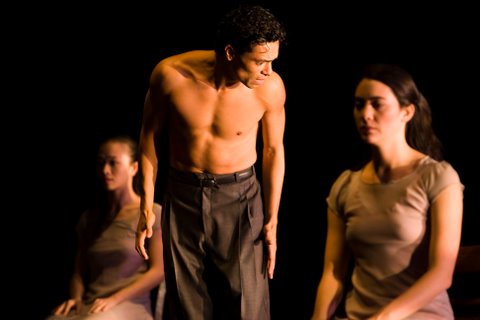
Daniel Fetecua Soto in Anna Sokolow's Rooms
In "Panic," Fetecua Soto, tense and bare-chested, sat in his chair like a criminal awaiting execution. Four other seated figures surrounded him yet ignored his very existence. They stared ahead as if frozen, then, one by one, abandoned the scene. Fetecua Soto's character grew more and more twitchy, shielded his face with his palms as he whipped his head back and forth, and finally, seemingly pushed over the edge of sanity by his plight, abandoned himself to nothingness.
The haunting jazz score, created for Rooms by Kenyon Hopkins, was played live by the Manhattan School of Music Jazz Ensemble, conducted by Justin DiCioccio. As is always the case when live music serves as choreography's partner, it made all the difference.
Early in March the Limón company played the 92nd Street Y--a haven for major and minor moderns back in the day--with a program of works by Limón and dance makers who were his contemporaries: Sokolow, Daniel Nagrin, and Donald McKayle. The dancing was much feistier than in the earlier performance, I'm glad to report. Unfortunately though, the format of offering fragments to represent work by the fellow toilers in the field felt "educational" rather than theatrical. The highlight of the program was Limón's 1947 La Malinche, reconstructed and directed by Sarah Stackhouse, a former Limón star.
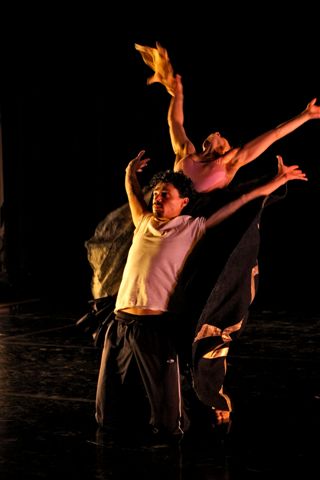
Daniel Fetecua Soto and Kathryn Alter in Limón's La Malinche
The shape and nature of La Malinche is startlingly close to Graham's 1940 El Penitente, with a troupe of three that arrives to present a primitive morality play in a village square, then, having imbued the roles with personal passion, moves on, presumably to give the same performance in the next town. The faux-naif dance style is also very close to the one Graham used for her piece. Did Limón borrow too freely? Or, perhaps, did Graham? There's evidence that Limón had begun developing the dance that became La Malinche as early as the mid-1930s, and that his 1939 Danzas Mexicanas was a concrete result of the way his imagination had been working. In either case, it's useful to think of Graham's frequent comment: "I only steal from the best."
The story told in Limón's piece, which is set to a serviceable score by Norman Lloyd, is one that the choreographer remembered seeing enacted in his childhood: A Mexican-Indian woman (La Malinche) is lured into abetting the European conqueror of her land (El Conquistador--that is, Cortez), who reduces the local inhabitants to slavery. Having betrayed her people--represented by a native man who is her rightful partner (El Indio)--she repents after her death, returning as a ghostly presence to support him in the revolution against oppression.
The plot may sound corny today, but the astute simplicity of the choreography makes it convincing. The dancing, by Alter, Fetecua Soto (as the good guy), and Dante Puleio (the bad guy) hit all the right notes of dictatorial complacency, succoring womanhood, and rebellious fervor without fuss or exaggeration.
Meanwhile, the Sokolow troupe gave a single performance on February 14 at the 92nd Street Y to honor the 100th anniversary of the choreographer's birth. The group represents a heroic effort by Jim May, once a dancer with Sokolow, to show us her greatest gift: the ability to fuse the rules governing a "well-made" dance (clarity, classically balanced structure, and so on) with invention and emotional authenticity.
The program comprised numerous small works and excerpts from larger ones. It included two latter-day versions of the 1945 female solo Kaddish (set to Ravel), which refers to the Holocaust by evoking the Jewish prayer for the dead; Ballade (Scriabin), a fresh-as-springtime quartet that represented Sokolow in her lyrical vein; and excerpts of earthier pieces such as Kurt Weill; Frida (an evocation of Frida Kahlo, the doom-eager and doom-plagued Mexican painter); and Murals, recently resurrected by May.
The problem with finding a sizable, steady audience today for work like Sokolow's lies in the pieces' seeming too small in scale and impact. (The histrionic behavior of Limón's outsize heroes, as they contend with the vagaries of fate or their own flaws, has a distinctly popular appeal.) Sokolow's work is quieter and more subtle. It's best seen in an intimate space, where the close-up view reveals the fine-tuned detail of both motion and emotion. For today's public, given what it has been schooled to appreciate, Sokolow's dances are not large and "loud" enough.
It's unfortunate, too, that the dancers May can commandeer just don't look fully professional, lacking the confidence and projection typical of seasoned performers. At best, a couple of the men seem promising. Most of the women lack the highly toned bodies of dancers who perform regularly. Yes, the group has clearly responded to May's coaching and can be admired for its sincerity of purpose. But May's quest is in a race with time, the great obliterator.
Photo credits: Limón: unidentified; Sokolow: Lionel Fredman; There Is a Time: David Levy; Rooms: Meems; La Malinche: Julie Lemberger
© 2010 Tobi Tobias
Paul Taylor Dance Company / City Center, NYC / February 24 - March 14, 2010
Paul Taylor's Also Playing--one of the pair of new dances featured in his company's February 24 - March 14 season at City Center--is "dedicated to all Vaudevillians, especially those who went on no matter what." The man knows what he's talking about. In 1974, Taylor, himself a unique and fabulous dancer, collapsed on stage from chronic illness and exhaustion, ending his performing career. A year later, however, he created Esplanade, a work of sheer perfection that has become his signature piece. This through-dark-to-light scenario, with its insistence on persevering no matter what, is an emblem of Taylor's artistic career and the story of his company as well. Despite the grueling work demanded of them and the chronic specter of inadequate funding, both choreographer and company have managed to survive--and triumph.
Also Playing is a mixture of Taylor's love for old time entertainment and gentle fun at its expense. It's set to a medley of excerpts from Donizettii's Dom Sébastien and L'assedio di Calais. (You know these ebullient, catchy tunes, believe me.) Santo Loquasto has created a ornate black-and-white proscenium for the occasion and Jennifer Tipton has lighted its "curtain" in scarlet, a witty economy. Said curtain rises on the first of 15 short "acts," each of which is a take on the generic fodder for yesteryear's vaudeville revues.
The opener is a girlish quintet, all tutued up, who have apparently reached the advanced-beginner stage of their ballet training. They're cavaliered (I use the word advisedly) by a pair of dangerously underqualified men who are clearly happier in the following soft-shoe routine.

Jeffrey Smith hoofing it among the flowers, in Paul Taylor's Also Playing
Photo: Tom Caravaglia
Next comes a tap number lead by a guy gotten up as a dancing horse with a tail and mane subjected to frequent perms. Then there's an old-fashioned waltz--for a soldier sporting exaggerated epaulets and a lady in an extravagantly beruffled skirt. Balanchine has presented their Platonic version on several occasions.
Have I mentioned that, throughout all the show's numbers, we can glimpse the "artistes" behind the scenes, so to speak, making quick crossovers from one side of the stage to the other for their next entrance and frenetically quick changes for their next role? We're allowed to see this through the translucent backdrop and a murky upstage corner representing the wings of the limelighted performance space. Call it the layered look, if you will, and think of the scene as choreographed by an inordinately deft traffic cop. Think again and discover that Taylor is commenting not only on the vaudevillians' life in the theater but also on that of his company.
The show goes on with a strip teaser (Eran Bugge), swishing her rump at her audience and a dying swan, pointe shoes and all (Julie Tice), accompanied by three mourners in inky veils and black corsets. Laughably inept, their efforts are nevertheless touchingly sweet and earnest. The fast-paced bill continues with an apache duet in which the woman (Michelle Fleet) gives as good as she gets (and in high heels too); a gypsy trio with Parisa Khobdeh at its heart; a garland dance with many a dropped petal; an Egyptian duet in which the two players move in the profiled stance Taylor used so spectacularly in his Sacre du Printemps (The Rehearsal); a female bullfighter (Annmaria Mazzini) taunting three cowardly bulls with her gloriously sleazy red satin cape; and, by way of a finale, a parade of people in white practice clothes (Onward, dancers!) led by an exhilarated woman (the vivacious Fleet) waving an American flag.

Robert Kleinendorst in Paul Taylor's Also Playing
Photo: Tom Caravaglia
A stagehand, Robert Kleinendorst, has been present throughout, wielding his broom to sweep away the fallout (you'd be surprised) from each act and hoofing a little on the sidelines as he watches. Towards the end of the show, he gets his big chance--with a captivating solo in which he and his sweeping tool, a kind of fifth limb, dance full-out with utter aplomb.
Brief Encounters, the other Taylor work new this season, may be a first for the choreographer. As haunting as a fragrance, it's suffused with romantic atmosphere and keen--often touching--observations about sexual propositions, yet it's laced with Taylor's brand of crass jokery. Rarely, if ever, has Taylor combined these two familiar modes of his in a single piece. The two still make awkward bedfellows but, with ongoing performance and perhaps some second thoughts, they--like man and wife in an arranged marriage--may mesh. As for me, I loved the dance at first sight.

Julie Tice and Michelle Fleet in Paul Taylor's Brief Encounters
Photo: Tom Caravaglia
Set to Debussy's Le Coin des Enfants (Children's Corner), Brief Encounters is performed in front of a dark, bronze-tinted curtain by Santo Loquasto, which depicts successive arches over a corridor leading to an unknown destination. The 11 dancers are clad (barely) by Loquasto in the briefest (hence the pun of the title) of black bikini bottoms and, where called for, bras. Still, their primary "costume" is the glow of their exposed, tautly muscled flesh under James F. Ingalls's inspired lighting.
Despite the title of the music, Taylor's piece is definitely PG but, like the celebrated film from which the dance co-opts its name, its erotic content remains prelapsarian. At first the dancers circle, stealing looks at each other as possible sexual partners. But even the occasional touch--tender palm to dancer-taut buttock--has no sequel; the group vanishes as quickly as a fleeting memory. (All the encounters in this piece are, as the title promises, tantalizingly brief and the more suggestive for it.)
Next we see a melancholy man (the wonderful James Samson, consummately full-bodied but eternally innocent) who hasn't yet defined what he desires, though he wants something passionately and is frustrated by not finding it. He might be The Sleeping Beauty's Prince Désiré, before the Lilac Fairy sets him up with Aurora.
One by one, a number of women, each gorgeous in a different way, approach him but then retreat. Finally he's surrounded by a quartet of men, who eye him intently; they too withdraw, seemingly because of his failure to respond. Here Taylor is describing--with the choreographic equivalent of perfect pitch--the misery of the young person who is unsure of himself as a potential lover, unsure even of his sexual identity.
Two trios--two men with a single woman, two women with a sole man--dance simultaneously until one person drops out of each group, leaving a male pair and a female pair. This initiates the most recent step in Taylor's slow progress toward allowing himself to depict same-sex couples onstage, celebrating the love (and lust) that can now finally speak its name. Later in the piece, the choreographer throws reticence to the winds and links two men in a series of handsome acrobatic postures, making them look like copulating gods.

Sean Mahoney and Francisco Graciano in Paul Taylor's Brief Encounters
Photo: Tom Caravaglia
Amy Young dances narcissistically with a hand mirror, adoring her own image, even when a suitor arrives to partner her. When he, very sensibly, draws back, she's disappointed by her reflection and hurls her looking glass away.
Next we ogle a five-woman harem, which . . . well, what do you imagine those multiple wives did when there was only one sultan available to satisfy their hunger? The women run off in a line and a line of eager men follows them, leaving the coolly beautiful Michael Trusnovec--Taylor's muse--behind. A discontent beauty played by Julie Tice joins him, but another man intrudes to threaten Trusnovec with a gleaming dagger, in the mode of would-be exotic silent films.
And so it goes, with the theme of thwarted love depicted in terms that range from profound appeals to your empathy to absurd slapstick. Brief Encounters is a bagatelle, to be sure, but it reminds you of the times, not restricted to your adolescence, when you couldn't make love work.
© 2010 Tobi Tobias
Sitelines
AJ Ads
 360° Dance Company at DTW offers two socially relevant revivals, Jane Dudley’s solo “Time Is Money” (1932) and Mary Anthony’s “Devil in Massachusetts” (1952) as well as the World Premier of Artistic Director, Martin Lofsnes' "6-1".
360° Dance Company at DTW offers two socially relevant revivals, Jane Dudley’s solo “Time Is Money” (1932) and Mary Anthony’s “Devil in Massachusetts” (1952) as well as the World Premier of Artistic Director, Martin Lofsnes' "6-1".
AJ Blogs
AJBlogCentral | rssculture
Terry Teachout on the arts in New York City
Andrew Taylor on the business of arts & culture
rock culture approximately
Laura Collins-Hughes on arts, culture and coverage
Richard Kessler on arts education
Douglas McLennan's blog
Dalouge Smith advocates for the Arts
Art from the American Outback
Chloe Veltman on how culture will save the world
For immediate release: the arts are marketable
No genre is the new genre
David Jays on theatre and dance
Paul Levy measures the Angles
Judith H. Dobrzynski on Culture
John Rockwell on the arts
innovations and impediments in not-for-profit arts
Jan Herman - arts, media & culture with 'tude
dance
Apollinaire Scherr talks about dance
Tobi Tobias on dance et al...
jazz
Howard Mandel's freelance Urban Improvisation
Focus on New Orleans. Jazz and Other Sounds
Doug Ramsey on Jazz and other matters...
media
Jeff Weinstein's Cultural Mixology
Martha Bayles on Film...
classical music
Fresh ideas on building arts communities
Greg Sandow performs a book-in-progress
Harvey Sachs on music, and various digressions
Bruce Brubaker on all things Piano
Kyle Gann on music after the fact
Greg Sandow on the future of Classical Music
Norman Lebrecht on Shifting Sound Worlds
Joe Horowitz on music
publishing
Jerome Weeks on Books
Scott McLemee on books, ideas & trash-culture ephemera
theatre
Wendy Rosenfield: covering drama, onstage and off
visual
Public Art, Public Space
Regina Hackett takes her Art To Go
John Perreault's art diary
Lee Rosenbaum's Cultural Commentary
